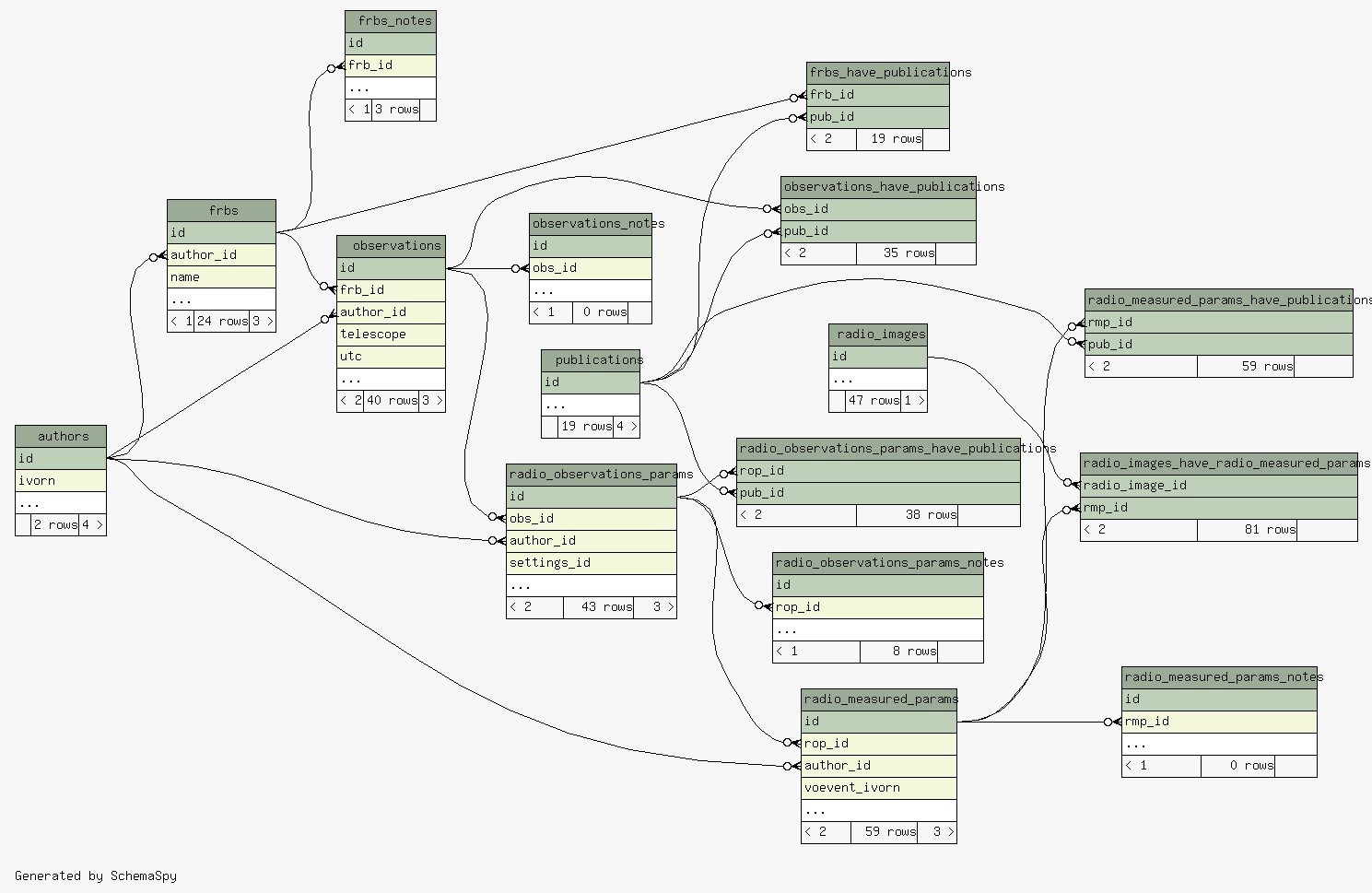Welcome to pyfrbcatdb’s documentation!¶
frbcatdb¶
The frbcatdb is a database to store a catalog of Fast Radio Bursts (FRBs). The DB is intended to contain old FRB events as well as new FRBs detected by the AA-ALERT FRB detection pipeline from Apertif observations and also possible follow-up observations or others FRBs detected by other telescopes. The frbcatdb is attached to the VOEvent backbone and uses this infrastructure as its source.
The db folder contains scripts to create an empty frbcat DB (create_db.csh), to import it from an existing dump file (import_db.sh) and to dump an existing DB to a dump file (dump_db.csh). It also contains the model (Entity-Relationship diagram).

The pyfrbcatdb is Python package for manipulating the frbcatdb and its linking
with the VOEvent backbone.
pyfrbcatdb usage¶
A default configuration file is installed in /etc/pyfrbcatdb/dbase.config. In this file the FRBCat database configuration can be defined. Alternatively, a user may supply their own configuration file with a command line argument of the executable, or define the database configuration via argument switches, or, alternatively via environment variables.
For inserting a VOEvent XML file into the FRBCat database, the decode_VOEvent executable is used:
- ::
- usage: decode_VOEvent [-h] [-c MY_CONFIG] –dbName DBNAME [–dbHost DBHOST]
- [–dbPort DBPORT] –dbUser DBUSER [–dbPassword DBPASSWORD] [–CSV CSV] [–log LOG] [VOEvent [VOEvent …]]
Process VOEvent XML file and add it to FRB database Args that start with ‘–’ (eg. –dbName) can also be set in a config file (/etc/pyfrbcatdb/dbase.config or specified via -c). Config file syntax allows: key=value, flag=true, stuff=[a,b,c] (for details, see syntax at https://goo.gl/R74nmi). If an arg is specified in more than one place, then commandline values override environment variables which override config file values which override defaults.
- positional arguments:
- VOEvent List of VOEvent XML files
- optional arguments:
-h, --help show this help message and exit -c MY_CONFIG, --my-config MY_CONFIG config file path --dbName DBNAME name postgres database [env var: dbNameFRBCat] --dbHost DBHOST name postgres database [env var: dbHostFRBCat] --dbPort DBPORT name postgres database [env var: dbPortFRBCat] --dbUser DBUSER user postgres database [env var: dbUserFRBCat] --dbPassword DBPASSWORD user postgres database password [env var: dbPasswordFRBCat] --CSV CSV CSV filename to dump database to [env var: CSVFRBCat] --log LOG log file, default=[HOME]/pyfrbcatdb_decode.log --zenodo ZENODO upload CSV to Zenodo, access token [env var: zenodoFRBCat]
For inserting an image into the database, the frbcatdb-image executable is used. Apart from the database configuration, the tool takes two positional arguments. The first is the filename of the image to be added, the second is the ‘id’ in the ‘radio measurement params’ table that the image should be connected to:
- ::
- usage: frbcatdb-image [-h] [-c MY_CONFIG] –dbName DBNAME [–dbHost DBHOST]
- [–dbPort DBPORT] –dbUser DBUSER [–dbPassword DBPASSWORD] [–caption CAPTION] [–title TITLE] filename rmpid
Create VOEvent XML file from FRB database Args that start with ‘–’ (eg. –dbName) can also be set in a config file (/data/github/venv- aa/etc/pyfrbcatdb/dbase.config or specified via -c). Config file syntax allows: key=value, flag=true, stuff=[a,b,c] (for details, see syntax at https://goo.gl/R74nmi). If an arg is specified in more than one place, then commandline values override environment variables which override config file values which override defaults.
- positional arguments:
- filename Name of file to fetch from rmpid rmp_id
- optional arguments:
-h, --help show this help message and exit -c MY_CONFIG, --my-config MY_CONFIG config file path --dbName DBNAME name postgres database [env var: dbNameFRBCat] --dbHost DBHOST name postgres database [env var: dbHostFRBCat] --dbPort DBPORT name postgres database [env var: dbPortFRBCat] --dbUser DBUSER user postgres database [env var: dbUserFRBCat] --dbPassword DBPASSWORD user postgres database password [env var: dbPasswordFRBCat] --caption CAPTION figure caption --title TITLE figure title
For extracting a VOEvent from the FRBCat database, the create_VOEvent executable is used. Note that some features might still be missing for the current release from this utility.
- ::
- usage: create_VOEvent [-h] [-c MY_CONFIG] –dbName DBNAME [–dbHost DBHOST]
- [–dbPort DBPORT] –dbUser DBUSER [–dbPassword DBPASSWORD] [–log LOG] frb_ids [frb_ids …]
Create VOEvent XML file from FRB database Args that start with ‘–’ (eg. –dbName) can also be set in a config file (/etc/pyfrbcatdb/dbase.config or specified via -c). Config file syntax allows: key=value, flag=true, stuff=[a,b,c] (for details, see syntax at https://goo.gl/R74nmi). If an arg is specified in more than one place, then commandline values override environment variables which override config file values which override defaults.
- positional arguments:
- frb_ids List of frbs ids
- optional arguments:
-h, --help show this help message and exit -c MY_CONFIG, --my-config MY_CONFIG config file path --dbName DBNAME name postgres database [env var: dbNameFRBCat] --dbHost DBHOST name postgres database [env var: dbHostFRBCat] --dbPort DBPORT name postgres database [env var: dbPortFRBCat] --dbUser DBUSER user postgres database [env var: dbUserFRBCat] --dbPassword DBPASSWORD user postgres database password [env var: dbPasswordFRBCat] --log LOG log file, default=[HOME]/pyfrbcatdb_create.log